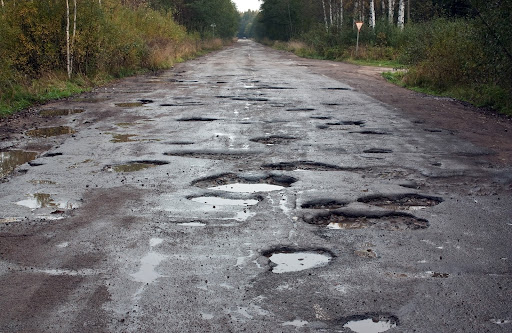
It is not uncommon to see potholes on asphalt surfaces. But what exactly causes potholes to form on asphalt? And is there a way to prevent them?
Potholes are unsightly. They can give customers a bad first impression of your business. Employees can also lose their motivation when forced to work in a poorly maintained environment. And, more often than not, if you have potholes in your parking lot, they can scare away drivers and potential clients.
Potholes also pose a threat to both vehicles and people. In 2021, potholes accounted for $26.5 billion in vehicle repairs. Drivers and passengers can also hurt themselves if they drive over a pothole. Pedestrians can trip over potholes and suffer injuries. When taken to court, you might be found liable for these damages because you failed to fix the potholes.
Obviously, there are no upsides to potholes, but understanding how potholes form is a good way to steer clear of them. Here are the top three causes of potholes on asphalt.
The first cause is poor construction. All asphalt surfaces require a durable foundation to support the heavy load of structures and vehicles. When the foundation is compromised due to poor construction, premature wear and tear will not take long to step in.
Why does poor construction happen in the first place? It all boils down to the contractor. Many contractors do a subpar job of constructing the asphalt and the overlay. They do this as a way to save time and money on the project so they can take on the next one. You might be satisfied with the quick completion, but the quality of the asphalt suffers as a result.
This is a bit tricky because construction mainly relies on asphalt companies and contractors. As such, you don’t really have much control over it. But, you can prevent poor construction by hiring a reputable company. Make sure to check reviews online and speak to their references personally. Performing this small yet critical step will greatly reduce the occurrence of potholes on asphalt driveways, roads, and parking lots.
Even with high-quality construction, potholes can still form on asphalt surfaces due to heavy traffic. Major roads and parking lots, in particular, are burdened by vehicles of all shapes and sizes. This constant flow of vehicular traffic will eventually cause the asphalt to crack due to natural wear and tear.
Over time, these cracks can expand, and water can seep into the ground. Asphalt potholes will then form. Potholes are also quicker to develop on the weaker areas of the pavement. This is because weak spots are more likely to bend, crack, and crumble under the weight and pressure of vehicles.
Try as you may, though, traffic really isn’t something you can prevent. For businesses, it is even something you encourage. High traffic in your parking lots and roadways means more customers.
Water is the primary cause of asphalt deterioration. It is the major contributor to erosion, in addition to the wind, and easily washes the underlying soil away.
Water can pool underneath the asphalt when it finds its way into the cracks. Freezing temperatures can then cause the water to solidify, pushing the surrounding surface and even cracking the asphalt further. Once temperatures go up, the ice melts, and the asphalt contracts. As such, potholes in asphalt are more common in cold climates.
Another way water degrades asphalt is through standing water. Many asphalt surfaces naturally have dips and curves due to weak spots. When water accumulates in these spots, the weight of the water can damage the asphalt underneath. And the added pressure of vehicles driving over these puddles only accelerates the deterioration process.
As they say, prevention is better than cure. So how exactly can you prevent potholes from forming on asphalt surfaces?
Applying a sealant is a good way to protect the surface and prevent water from penetrating the asphalt. For driveways, applying an asphalt sealer within 6 months of installation is important. Then, repeat the application once every year.
If you find cracks on the asphalt, make sure to seal them as soon as possible. This will prevent water from accumulating underneath and possibly eroding the subgrade. While sealing does not increase the structural integrity of the asphalt, it does help protect it from the causes of potholes.
Another way to “seal” the asphalt is to add an overlay on top. Unlike traditional sealing, overlays do add structural integrity to the pavement. This method is more thorough, so it also takes more time and money to complete.
Pothole patching is when you apply a patching material to a pothole. This is then followed by compaction, either by hand or with the help of equipment. It is a localized method of fixing potholes and cracks, but it does not address the root cause of the problem. As such, it is a temporary form of preventing future potholes.
As you can see, there are three main causes of potholes on asphalt – poor construction, heavy traffic, and water/erosion. While you can’t control contractors, traffic, or the weather, you can still do some things to prevent potholes from forming. These include applying a sealant, using an overlay, and patching.
RELATED ARTICLES: